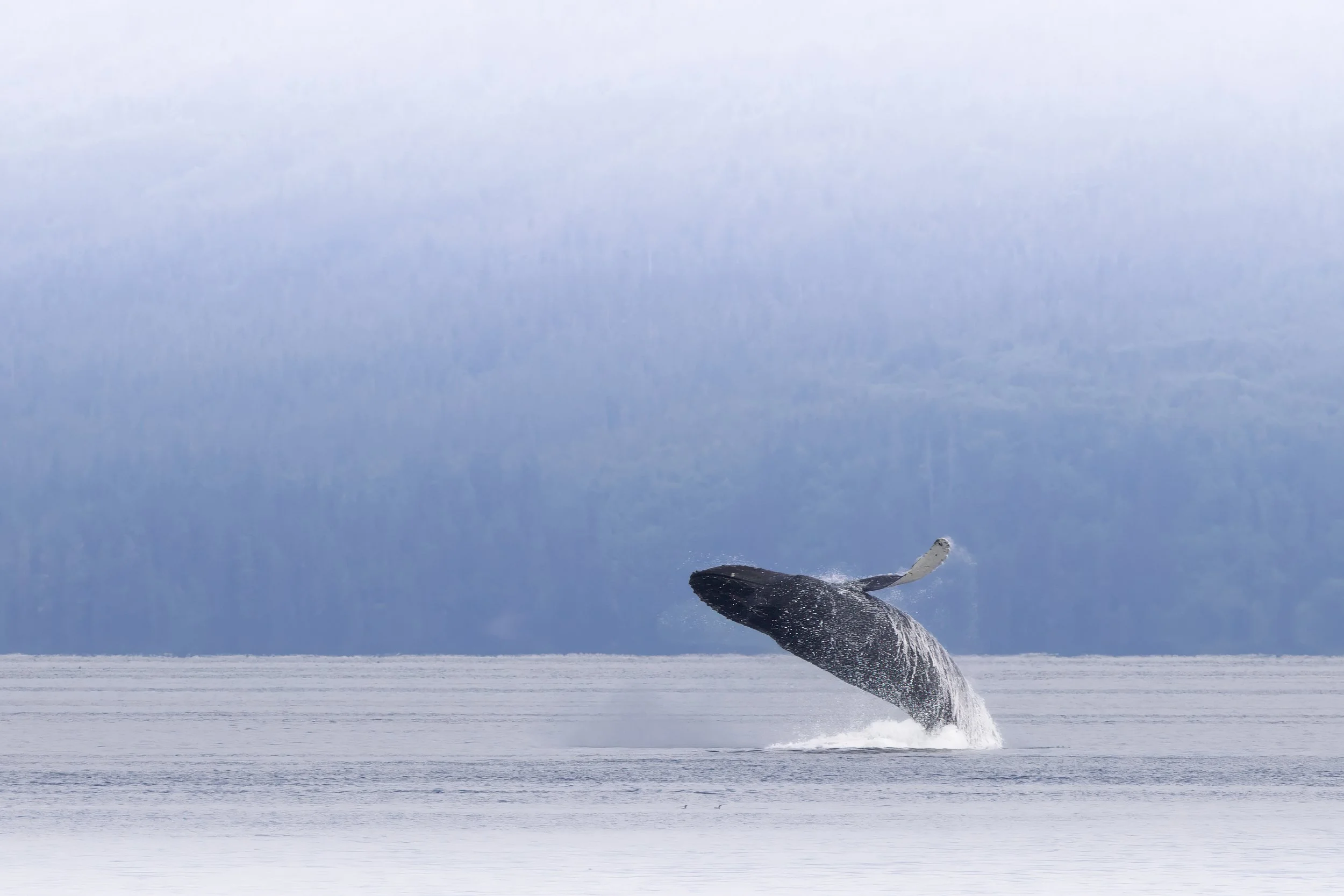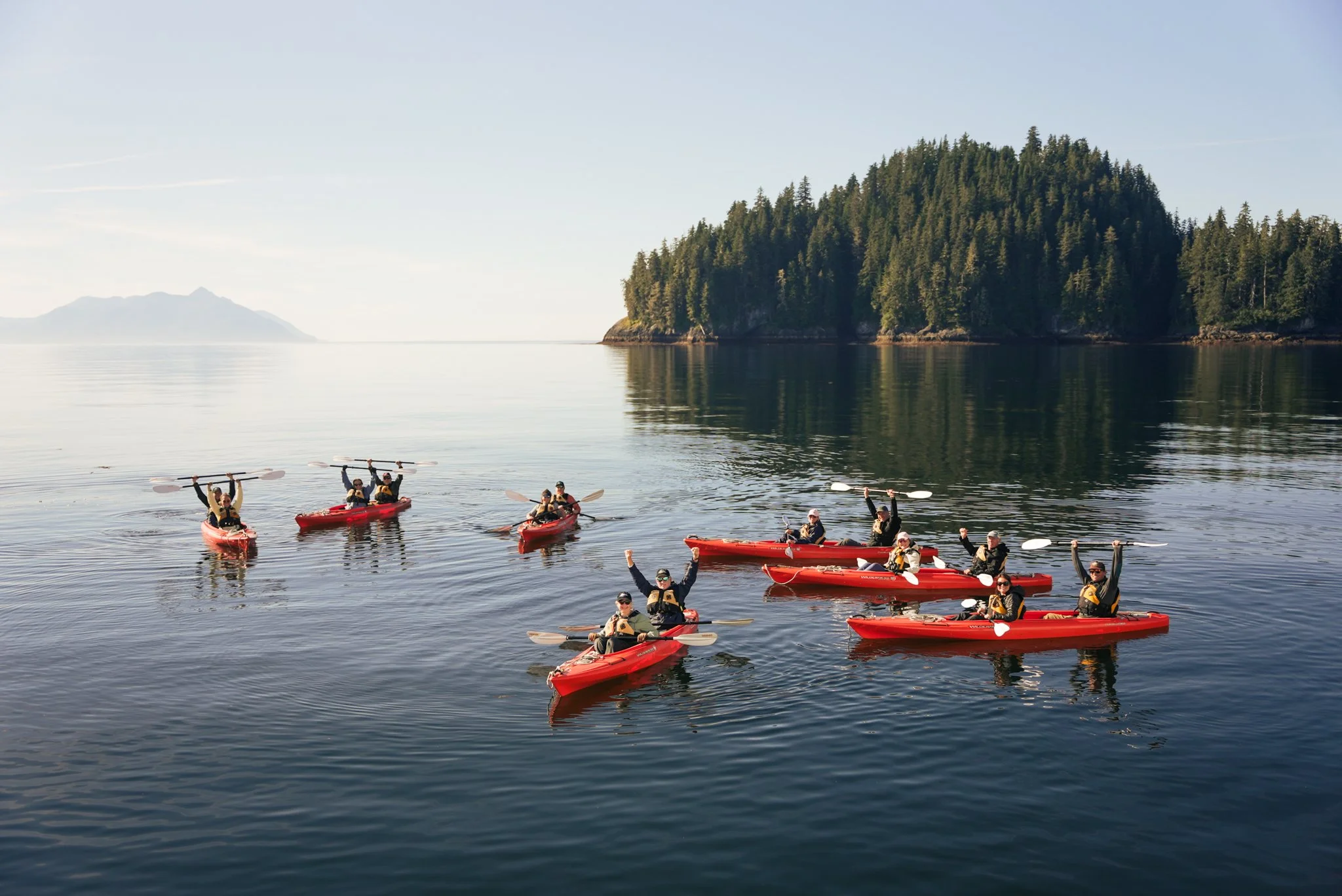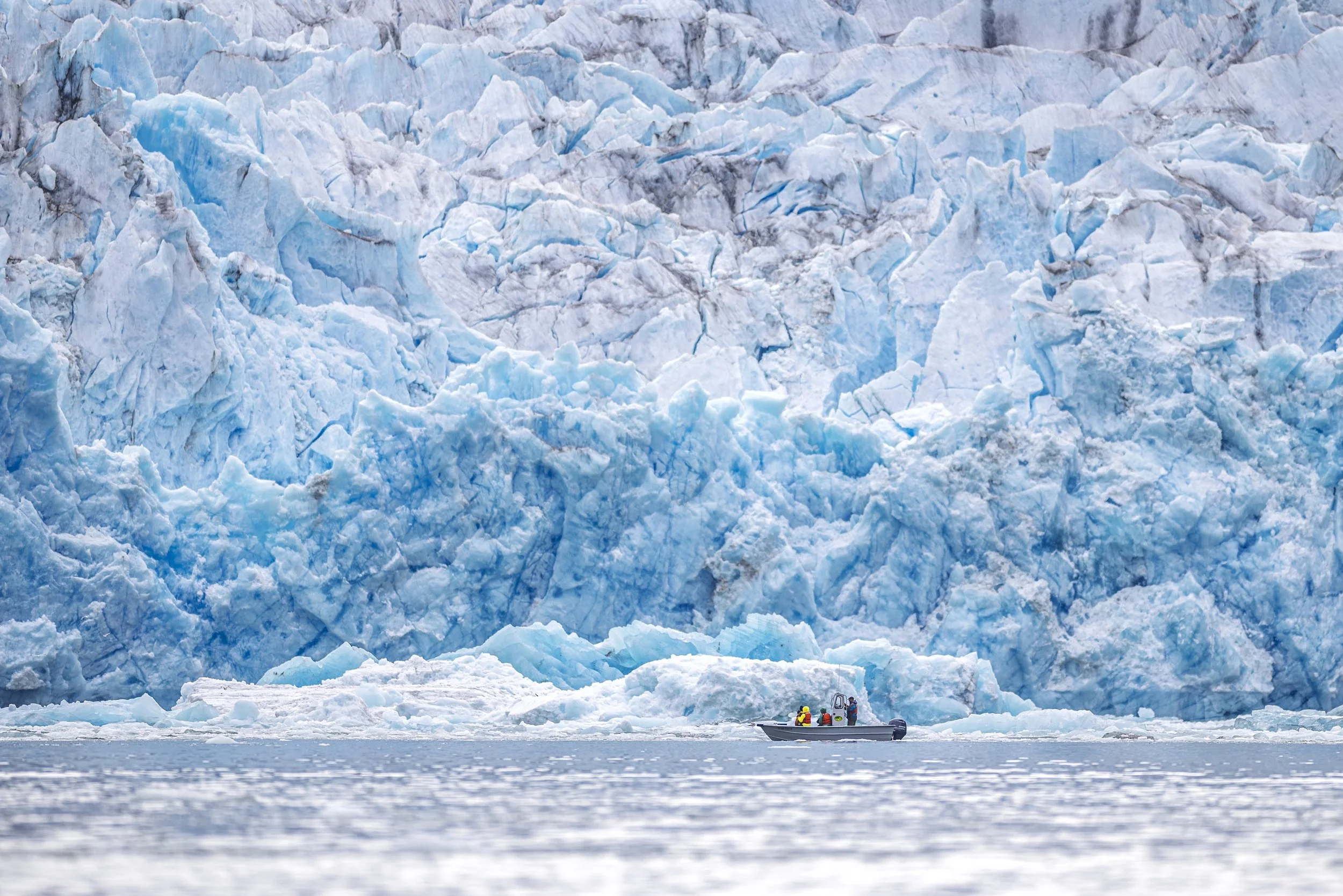Spring Awakening in Alaska: Waterfalls, Wildlife, and Why May & June Are the Secret Season to Cruise the Tongass
A Season Few See, but Everyone Should
When people ask our guides, “When’s the best time to visit Alaska?” they expect us to say July.
The truth? Some of the most spectacular weeks in Southeast Alaska happen long before peak summer crowds arrive.
From May through early June, the Tongass National Forest is waking up — a brief, brilliant interval when the entire ecosystem is in motion. Waterfalls pour from every mountainside, whales begin returning from Hawaii¹, brown bears start emerging along the shorelines of Baranof and Chichagof Islands² — and sometimes even engage in their spring courtship rituals, a rare and thrilling glimpse into the season of renewal in the Tongass¹³ — while Sitka black-tailed deer move down to feed on fresh green growth in tidal meadows¹⁴. The days stretch longer by the week. It’s a season of first light and fresh energy — what we call spring awakening — and it’s the hidden gem of the Inside Passage.
“The moment when Alaska takes its first deep breath.”
As the conservation organization SeaBank notes, the Tongass is home to more than 80 species of marine and terrestrial mammals — a biodiversity density unequaled in any other U.S. National Forest. Deer, bears, wolves, and eagles depend on its old-growth habitats to thrive — a living example of what a coastal temperate rainforest looks like when allowed to endure¹⁵. Southeast Alaska alone hosts about 40 percent of all bird species found in North America¹⁶, making this region one of the continent’s most important wildlife strongholds.
It also happens to be the favorite season of The Boat Company’s long-time environmental attorney, Paul Olson — a seasoned Alaskan fisherman and lifelong advocate for the Tongass. He calls this time of year “the moment when Alaska takes its first deep breath.”
The Waterfall Coast in Full Flow
In May and early June, meltwater from the island snowfields transforms Baranof Island’s eastern shore — the fabled Waterfall Coast — into a living sculpture of motion. For guests aboard our vessels, the M/V Liseron and M/V Mist Cove, it’s a front-row view to hundreds of temporary falls that spill directly into the sea.
By midsummer, many of these cascades slow to a trickle. But in May and early June, they roar. It’s the only time of year when every inlet feels alive with motion and sound — mist rising from cliffs, sunlight catching droplets in the air, and reflections shimmering across calm fjord waters. Photographers often say this is when Southeast Alaska feels most cinematic.
This coastline isn’t just scenic — it’s geological storytelling in motion, a snapshot of how meltwater shapes the islands every single year³.
Wildlife on the Move: The Great May–June Migration
May and early June in the Tongass are a feast in motion.
Humpback whales arrive from their winter nurseries in Hawaii, following schools of herring that return to spawn¹,⁴. Early bubble-net feeding — those breathtaking moments when small groups of whales work in perfect unison to herd fish toward the surface — may start to appear this time of year¹.
Along the same currents, Steller sea lions and harbor seals gather to feed⁵. Brown bears emerge from their dens and can sometimes be seen foraging along shorelines for sedge grass or shellfish — and occasionally you may even observe boars and sows interacting during mating season, which typically peaks in May and June¹³. Late spring marks the beginning of bear courtship, a rare reminder that the wilderness has its own timing and rhythm.
Meanwhile, Sitka black-tailed deer — a subspecies found only in coastal Southeast Alaska — are most visible during the spring “green-up,” when they descend to low elevations to feed on the first tender shoots of vegetation¹⁴. Guests may spot them grazing in tidal meadows or at the forest edge before they begin migrating back upslope later in June. Deer populations throughout the ABC Islands are currently thriving after a decade of mild winters, offering the best viewing opportunities of the year.
Overhead: The Return of Alaska’s Spring Skies
The birdlife in spring and early summer is nothing short of extraordinary. Bald eagles begin nesting along the shoreline as early as April, often returning to the same massive old-growth nests each year — and Southeast Alaska hosts the largest concentration of bald eagles in North America, estimated at roughly 25,000 birds¹⁷. Marbled murrelets, black oystercatchers, and pigeon guillemots nest along rocky cliffs and sheltered coves⁶, while gulls and sea ducks fill the channels.
During the Boat Company’s “Glacier Day” transit through Stephens Passage, guests travel through an Audubon-designated Important Bird Area — one of global significance for both resident and migratory species. Here, it’s common to see arctic terns, pelagic cormorants, pigeon guillemots, tufted puffins, and mew and glaucous-winged gulls nesting on the rocky islets and cliffs that line the passage.
While Boat Company vessels don’t visit the Stikine Delta itself, the Stephens Passage region near Juneau offers glimpses of these migrations as shorebirds and sea birds move northward in May and June. Southeast Alaska hosts roughly 70 percent of bird species found in the state and 40 percent of those in North America¹⁶, with most arriving between late April and early June to feed, rest, and breed before continuing to the Arctic. That makes this season a quiet highlight for serious birders — a chance to witness both resident nesting and migratory movement within the same day.
And in the muskegs and spruce, the soundscape changes: varied thrush, ruby-crowned kinglets, and hermit thrushes return from southern winter ranges⁹, their songs joining the steady cry of ravens and the occasional drumming of woodpeckers.
Solitude and Early-Season Calm
While large cruise ships begin increasing their numbers in Sitka and Juneau by late June, May and early June remain among the calmest, most contemplative times to explore. There are often fewer private yachts and sightseeing flights, and more quiet anchorages open to smaller vessels.
The Boat Company experience is always intimate — just 20–24 guests per ship — but these early voyages carry an extra hush. Towns are calmer, travel routes less hurried, and evenings stretch longer, filled only with the hiss of the tide and the call of a raven.
Even the light itself seems to linger in early summer. Daylight expands rapidly through May and June, with sunsets lingering past 10 p.m. and golden light glazing the fjords long into the evening¹⁰. It’s what we like to call “the photographer’s Alaska” — where the light lasts long enough to breathe between shots.
Fishing, Weather, and Honest Expectations
By May, salmon runs have not yet begun, but lingcod, halibut, and pelagic rockfish seasons are open¹¹. Lingcod typically opens May 16 in Southeast Alaska, while halibut and rockfish can be caught throughout the spring. For anglers, it’s a diverse season — a time for quiet mornings casting from the skiff, learning new techniques, or simply watching the wilderness wake.
Those who wade into remote streams may also try for Dolly Varden char, which make their own spring migration toward the sea. Strap on waders and step into a pristine forest creek to cast for these beautifully-spotted fish as they feed in the clear, cold water. And for the culinary adventurous, spring’s lower tides can occasionally offer a chance to observe or responsibly harvest shellfish such as Dungeness crab or butter clams (where regulations allow)¹⁸.
Weather in the Tongass is famously unpredictable, which is part of its magic. Spring and early summer often bring a mix of bright breaks, misty rain, and glassy calm¹² — a dynamic palette that shapes each trip uniquely. Visibility for photography and wildlife viewing is often excellent, and the long light can make even moody skies cinematic.
Every season has its own rhythm, but early summer in the Tongass tends to balance freshness and stability — temperatures mild, winds often gentle, and the scenery newly alive after winter’s retreat.
Every year tells its own story — but whether it’s sunlit waterfalls or rain-polished cliffs, this season brings the Tongass alive in ways that surprise even locals.
The Energy of a New Season
The Boat Company crew often say the same thing every year: the first few trips feel like a homecoming. The boats gleam after winter refits, and everyone’s eager to see what’s changed — what birds have arrived, what glacier faces have shifted, what stories the forest will tell this year.
Guests often sense that energy without realizing it; there’s a shared excitement that comes from witnessing the wilderness as it reawakens. It’s not just the landscape that comes alive — it’s the people, too. The crew, the guests, even the seasoned Alaskans like Paul Olson who return each year with the same spark.
By May and June, the entire ecosystem feels newly in rhythm: bears strong and foraging, deer bright in their coats, whales surfacing with new calves, and seabirds filling the skies. Spring is also when brown bears begin their mating season — what naturalists sometimes call “bear romance.” Though sightings are never guaranteed, this courtship behavior marks one of the most fascinating natural cycles of the year, quietly unfolding across the Tongass¹³.
It’s the time when everyone and everything — from whales to crew — is freshly tuned to the rhythm of the season.
Why May and Early June Are the Secret Season
Waterfalls at their peak
Earliest whale activity returning from Hawaii
Potential sightings of bears, deer, sea lions, and seals feeding along shorelines
Potential glimpses of spring bear courtship behavior — a hallmark of this time of year, even if unseen¹³
Peak May–June bird migration for both seabirds and songbirds
Longer daylight hours and cooler “cool-cation” temperatures
A more peaceful travel cadence before peak summer
The personal favorite season of Paul Olson, The Boat Company’s environmental attorney and long-time Alaskan fisherman
Experience Alaska’s Spring Awakening
For travelers who prefer authenticity over crowds, May and early June offer the purest version of Southeast Alaska — wild, luminous, and alive with possibility.
This is the Alaska that moves at nature’s pace — a place of patience, reflection, and rediscovery. The Boat Company has spent more than 46 years leading travelers here, quietly and respectfully, under strict conservation guidelines that protect the wilderness we love.
Spring awakens the Tongass — and every person lucky enough to explore it.
Sources
NOAA Fisheries – Southeast Alaska Humpback Whales: fisheries.noaa.gov/alaska
Alaska Department of Fish and Game (ADF&G) – Brown Bear Natural History (Southeast Units 4 & 5): adfg.alaska.gov
DeArmond, R.N. & Roppel, P. (1997). Baranof Island’s Eastern Shore: The Waterfall Coast. Sitka: Arrowhead Press.
ADF&G – Pacific Herring Biology and Sitka Sound Spawn: adfg.alaska.gov
NOAA / ADF&G – Steller Sea Lion & Harbor Seal Distribution in Southeast Alaska: fisheries.noaa.gov
ADF&G / USFWS – Bear Foraging Behavior and Coastal Habitat Use in Southeast Alaska: fws.gov
ADF&G / NPS – Bald Eagle Abundance in Southeast Alaska: nps.gov
Audubon Alaska – Stikine River Delta Important Bird Area & Shorebird Migration: ak.audubon.org
Audubon – Varied Thrush and Songbird Migration Timing (Southeast Alaska): audubon.org
NOAA / US Naval Observatory – Southeast Alaska Daylength Data (May–June): aa.usno.navy.mil
ADF&G – Halibut and Lingcod Sport Fishing Regulations Area 2C (Southeast Alaska): adfg.alaska.gov
NOAA Climate Normals (1991–2020) – Southeast Alaska Precipitation and Wind Patterns: weather.gov
ADF&G – Brown Bear Mating Season & Behavior, Southeast Alaska (Units 4–5): adfg.alaska.gov
ADF&G – Sitka Black-Tailed Deer Seasonal Movements & Habitat Use (ABC Islands): adfg.alaska.gov
SeaBank / The Alaska Trust – Biodiversity of the Tongass National Forest: thealaskatrust.org/about-seabank











